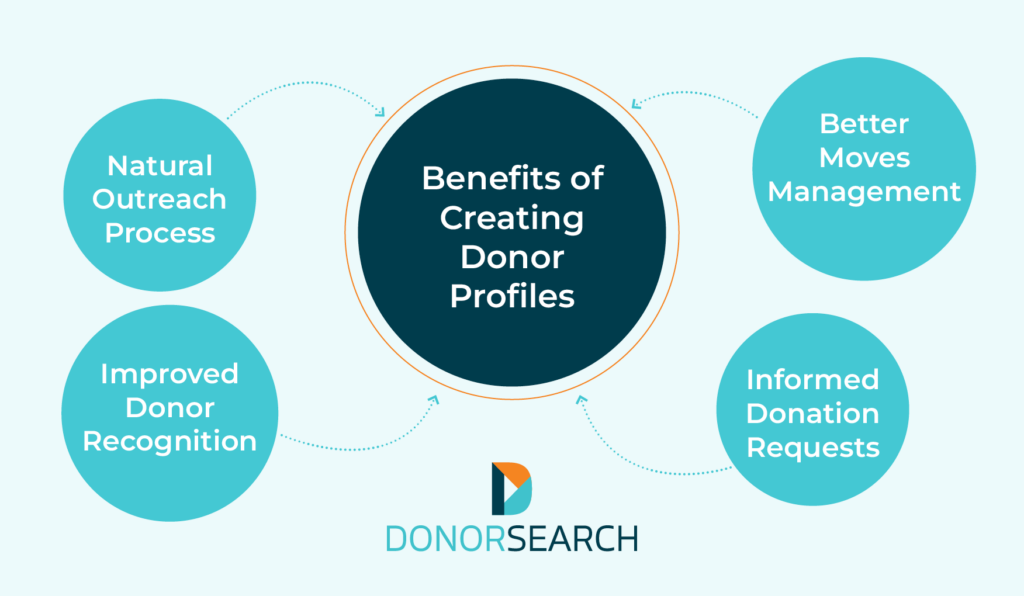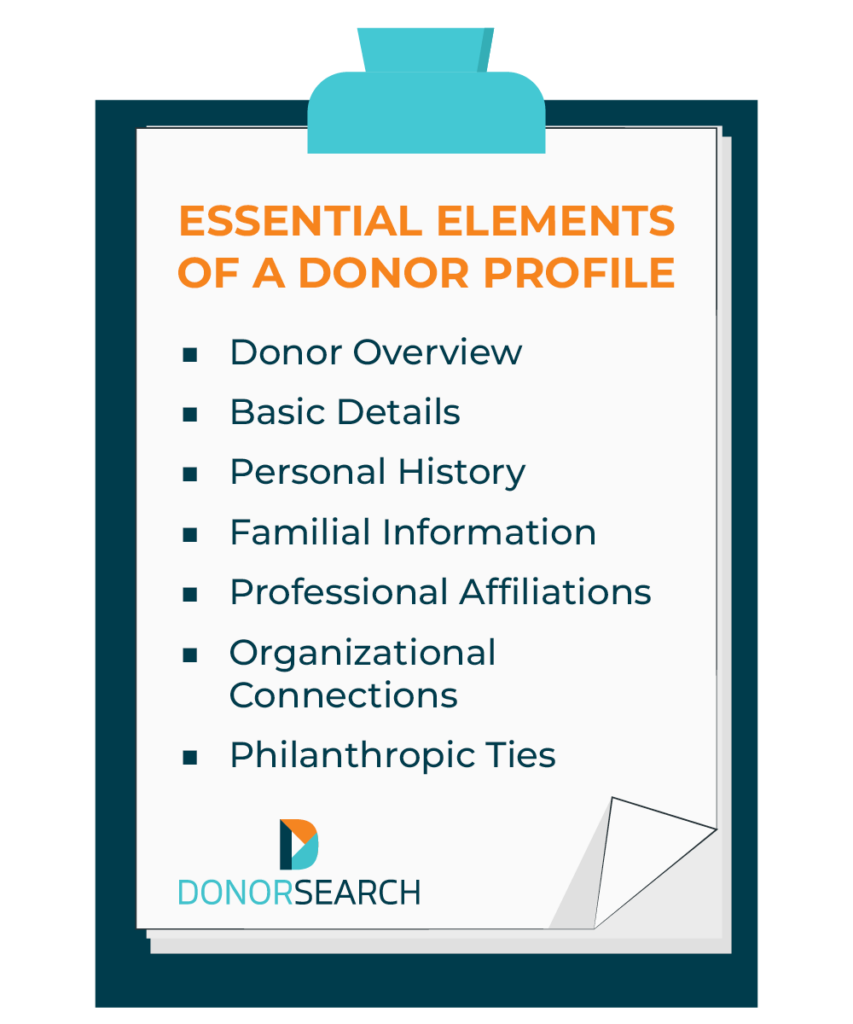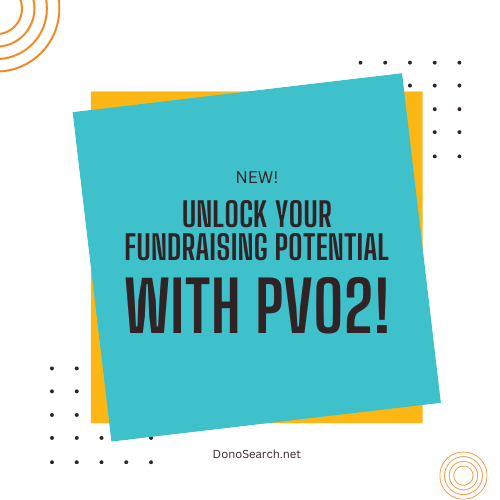
How to Create a Donor Profile: Ultimate Guide + Template
While donor cultivation is essential for your nonprofit to secure major gifts, it’s a long process. After identifying a potential donor, it can take months to build a strong enough relationship with them that you feel comfortable asking them to make a significant contribution. Then, once the prospect has converted, you need to continue to steward them so they continue supporting your organization.
Thorough donor profiles are a key tool for cultivating donors more efficiently. Donor profiles allow you to distill everything you know about a current or potential donor into a collection of actionable information that guides your interactions with them.
In this guide, you’ll learn all you need to know to create high-quality donor profiles, including:
- What is a donor profile?
- Benefits of Leveraging Donor Profiles
- Elements to Include in a Donor Profile
- DonorSearch’s Donor Profile Template & Tools
These resources will look different for every organization, but there are a few critical elements every profile should have to make it a useful tool for your team. Let’s get started by ensuring we’re all on the same page about what exactly a donor profile is.

What is a donor profile?
A donor profile is a digital resource that tracks all of the key information about a current nonprofit donor or donor prospect. Organizations typically gather this information from prospect research, direct communication with the donor, and data on their ongoing engagement with the nonprofit.
Your organization will likely store its donor profiles in its constituent relationship management (CRM) system. Your nonprofit can select a format and structure for donor profiles that works best for your team and aligns with your CRM’s capabilities, as long as everything is consistent between various profiles.
Think of your donor profiles as living documents. While you’ll create a new one as soon as you’ve identified a prospect, your major gift officer should easily be able to add the information they learn as the relationship develops. Then, once a prospect converts, continue to track their involvement with your nonprofit, as this information will help you tailor your stewardship plan and keep them engaged.
Benefits of Leveraging Donor Profiles
Information is power, especially for connecting with prospects and making fundraising appeals. To convince them to give, you have to demonstrate that you value them as a person who would want to join your organization’s community and become an integral part of furthering your mission, not just as an ATM with legs!
By storing key information about your donors in dedicated profiles, you can:

- Develop a more natural outreach process by recording donors’ contact information, communication preferences, and personal interests that could make good conversation topics.
- Strengthen your moves management system by tracking each interaction with a prospect to ensure your next move builds on the previous one.
- Make informed donation requests that donors will be receptive to based on their giving and engagement history.
- Recognize each donor in a way they’ll appreciate, then follow up with well-timed, tailored suggestions for continued involvement.
While it may take some time, your team will benefit from creating comprehensive prospect profiles. You can approach the major gift solicitation process with a better strategy and help donors take the next step in their donor journeys without risking miscommunication between team members or information getting lost. Plus, the more prospect profiles you create and use, the more you’ll learn about your nonprofit’s community of current and potential supporters.
Elements to Include in a Donor Profile
To truly get to know your donors and prospects, you’ll need to look at many different types of data. Once you’re ready to start compiling profiles for each of them, organize your data into the following seven sections:

1. Donor Overview
This section is designed to quickly brief your team on an individual’s current status. This includes whether they’re an existing donor or new prospect and where they are in their donor journey.
These details should include the individual’s:
- Name
- Date of last interaction with your nonprofit
- Giving status (e.g., prospective donor, one-time donor, repeat donor)
- Summary of past interactions
- Next moves
Whenever someone on your team reaches out to a donor or receives a message from them, they should update the date of last interaction and add information to the summary of past interactions in their profile. Then, you can plan your next interaction and list that as the next move. These interactions are critical for building a real, lasting relationship with a donor, so being able to reference an overview of those interactions will help you continue to make efficient progress with them.
2. Basic Details
Basic or demographic details are essentially a donor’s personal and contact information. It’s essential that your team keeps these files accurate and up-to-date so you always know how to reach out to your donors and prospects. If there are gaps in the basic details sections of several profiles, data appending can help fill them.
In this section, you’ll include the following information about each donor:
- Full name
- Preferred name or nickname
- Pronouns
- Phone number
- Email address
- Mailing address
- Preferred communication method
- Date of birth
Not only is this information important for getting in touch with a donor, but knowing it is the first step to showing you care about an individual. Addressing the donor by the correct name and pronouns, contacting them via a communication method they’ll respond to, and remembering their birthday are critical for starting your relationship with them on the right foot.
3. Personal History
As important as it is to know how to reach and address your donors, understanding them on a deeper level is key to building authentic connections with them and tailoring your donation requests. That understanding begins with knowing additional details about their personal history, including their:
- Alma mater(s)
- Degree(s)
- Connections to foundations
- Real estate holdings
- Public stock holdings
- Community involvement
- Hobbies, values, and interests
Some of these details will tell you whether a donor has the capacity to make a large monetary gift to your organization, and others will show if they have an affinity for your mission and work that would make them willing to do so. Rather than just inviting donors to give, you want to invite them to give to a cause that resonates with them and their values, as doing so will encourage further engagement and a longer, stronger relationship with your organization.

4. Familial Information
Gathering data on your donors’ families will be more helpful for some organizations than others. It’s particularly useful for universities, schools, and healthcare organizations with grateful patient programs since multiple family members will likely be involved in their donation processes.
But even if your organization doesn’t fall into one of these categories, knowing about a donor’s family can make your communications with your prospects more personal. Your prospects’ families are likely important to them, so you should show that your nonprofit also cares about them.
Include the following familial data in your donor profiles:
- Name of spouse
- Spouse’s philanthropic ties
- Spouse’s professional affiliations
- Key details on children
- Key details on other relevant relatives
Besides providing additional conversation topics, bringing donors’ families into the cultivation process can encourage them to get their families involved with your work. If you express interest in their children, for example, they might bring them to volunteer or attend an event. That way, you can plant seeds for the next generation to continue supporting your cause!
5. Professional Affiliations
A comprehensive professional affiliations section can help you gain a firmer understanding of a donor’s giving capacity and uncover potentially valuable connections. For instance, if one of your board members works for the same company as a prospect, you could ask that board member to introduce you to them.
Here are some key data points to include in this section:
- Employer
- Employer address
- Position
- Work email
- Work phone number
- Years with employer
- Relevant employment history
- Relevant business contacts
Additionally, professional affiliation information can indicate whether a donor’s employer offers corporate giving programs such as matching gifts or volunteer grants. If you know this information and discuss it with the donor, you can bring in even more revenue to fund your mission.
6. Organizational Connections
In this section of a donor profile, you can pinpoint exactly what motivates an individual’s philanthropy and how strong their bonds with your specific cause and nonprofit are. For a brand-new prospect, this category might be completely blank—revisit it as they begin to engage with your organization.
For existing supporters, this section should include:
- Date of last gift
- Amount of last gift
- Total number of donations
- Average gift size
- Board membership
- Volunteer engagement
- Event attendance
Past giving and involvement are the strongest indicators of future giving, so tracking these details will make a huge difference when looking for candidates to upgrade their giving. Plus, you can use past experiences with your nonprofit to motivate donors to get involved again.
7. Philanthropic Ties
While you have the strongest chance of securing a donation from someone who has already given to your organization, someone who has a history of engagement with another nonprofit also has great potential. If the prospect in question has donated to causes similar to yours, your nonprofit is in an excellent position to acquire that donor.
Here are the pieces of affinity-based information to include in this section:
- Charitable Giving Elsewhere
- Volunteering Elsewhere
- Board Membership Elsewhere
Don’t be afraid to reach out to someone who actively supports another nonprofit! Many people are willing to support more than one organization at a time, especially when the cause is close to their hearts.
DonorSearch’s Donor Profile Tools
DonorSearch offers several top-of-the-line solutions for your nonprofit to leverage when compiling donor profiles, including:
- A comprehensive prospect research database that contains more than a billion pieces of information about donors’ personal, professional, and philanthropic histories.
- A prospect generator platform (ProspectView Online 2) that summarizes prospect research data into actionable insights through customizable, AI-powered reporting.
- A predictive modeling solution (DonorSearch Ai) that segments prospects based on six probability scores so you can prioritize reaching out to those who are most likely to give.
- Partnerships and integrations with more than 40 donor databases and fundraising tools, including the nonprofit-specific AI content creation solution Momentum.
With an accuracy rate above 90%, DonorSearch is a trusted partner for more than 10,000 organizations of all shapes and sizes. Check out this video to discover how DonorSearch helped The Nature Conservancy identify, understand, and build relationships with its prospective donors:
Final Thoughts
With fully fleshed-out donor profiles, your organization will have everything it needs to effectively cultivate relationships that lead to long-term engagement and giving. Plus, as you revisit and update your profiles regularly, they’ll serve as the source of truth for your team members to truly get to know your prospects and donors.
Here are some additional resources where you can learn more about donor profiles and the best tools to help create them:
- Major Donor Fundraising: How to Strengthen Your Strategy. Discover a variety of additional strategies for cultivating major donors on top of creating donor profiles.
- 16+ Prospect Research Tools to Find More Donors for Your Org. Explore your options for prospect research solutions to help you gather data for your profiles.
- Fundraising Intelligence: Using AI to Enhance Philanthropy. Learn how artificial intelligence (AI) is shaping modern philanthropy, including donor data-gathering and relationship-building.


